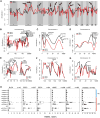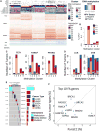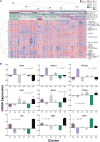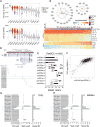Genomic, Pathway Network, and Immunologic Features Distinguishing Squamous Carcinomas
- PMID: 29617660
- PMCID: PMC6002769
- DOI: 10.1016/j.celrep.2018.03.063
Genomic, Pathway Network, and Immunologic Features Distinguishing Squamous Carcinomas
Abstract
This integrated, multiplatform PanCancer Atlas study co-mapped and identified distinguishing molecular features of squamous cell carcinomas (SCCs) from five sites associated with smoking and/or human papillomavirus (HPV). SCCs harbor 3q, 5p, and other recurrent chromosomal copy-number alterations (CNAs), DNA mutations, and/or aberrant methylation of genes and microRNAs, which are correlated with the expression of multi-gene programs linked to squamous cell stemness, epithelial-to-mesenchymal differentiation, growth, genomic integrity, oxidative damage, death, and inflammation. Low-CNA SCCs tended to be HPV(+) and display hypermethylation with repression of TET1 demethylase and FANCF, previously linked to predisposition to SCC, or harbor mutations affecting CASP8, RAS-MAPK pathways, chromatin modifiers, and immunoregulatory molecules. We uncovered hypomethylation of the alternative promoter that drives expression of the ΔNp63 oncogene and embedded miR944. Co-expression of immune checkpoint, T-regulatory, and Myeloid suppressor cells signatures may explain reduced efficacy of immune therapy. These findings support possibilities for molecular classification and therapeutic approaches.
Keywords: bladder carcinoma with squamous differentiation; cervical squamous cell carcinoma; esophageal squamous cell carcinoma; genomics; head and neck squamous cell carcinoma; human papillomavirus; lung squamous cell carcinoma; proteomics; transcriptomics.
Published by Elsevier Inc.
Conflict of interest statement
Michael Seiler, Peter G. Smith, Ping Zhu, Silvia Buonamici, and Lihua Yu are employees of H3 Biomedicine, Inc. Parts of this work are the subject of a patent application, WO2017040526 titled “Splice variants associated with neomorphic sf3b1 mutants.” Shouyoung Peng, Anant A. Agrawal, James Palacino, and Teng are employees of H3 Biomedicine, Inc. Andrew D. Cherniack, Ashton C. Berger, and Galen F. Gao receive research support from Bayer Pharmaceuticals. Gordon B. Mills serves on the External Scientific Review Board of Astrazeneca. Anil Sood is on the Scientific Advisory Board for Kiyatec and is a shareholder in BioPath. Jonathan S. Serody receives funding from Merck, Inc. Kyle R. Covington is an employee of Castle Biosciences, Inc. Preethi H. Gunaratne is founder, CSO, and shareholder of NextmiRNA Therapeutics. Christina Yau is a part-time employee/consultant at NantOmics. Franz X. Schaub is an employee and shareholder of SEngine Precision Medicine, Inc. Carla Grandori is an employee, founder, and shareholder of SEngine Precision Medicine, Inc. Robert N. Eisenman is a member of the Scientific Advisory Boards and shareholder of Shenogen Pharma and Kronos Bio. Daniel J. Weisenberger is a consultant for Zymo Research Corporation. Joshua M. Stuart is the founder of Five3 Genomics and shareholder of NantOmics. Marc T. Goodman receives research support from Merck, Inc. Andrew J. Gentles is a consultant for Cibermed. Charles M. Perou is an equity stock holder, consultant, and Board of Directors member of BioClassifier and GeneCentric Diagnostics and is also listed as an inventor on patent applications on the Breast PAM50 and Lung Cancer Subtyping assays. Matthew Meyerson receives research support from Bayer Pharmaceuticals; is an equity holder in, consultant for, and Scientific Advisory Board chair for OrigiMed; and is an inventor of a patent for EGFR mutation diagnosis in lung cancer, licensed to LabCorp. Eduard Porta-Pardo is an inventor of a patent for domainXplorer. Han Liang is a shareholder and scientific advisor of Precision Scientific and Eagle Nebula. Da Yang is an inventor on a pending patent application describing the use of antisense oligonucleotides against specific lncRNA sequence as diagnostic and therapeutic tools. Yonghong Xiao was an employee and shareholder of TESARO, Inc. Bin Feng is an employee and shareholder of TESARO, Inc. Carter Van Waes received research funding for the study of IAP inhibitor ASTX660 through a Cooperative Agreement among NIDCD, NIH, and Astex Pharmaceuticals. Raunaq Malhotra is an employee and shareholder of Seven Bridges, Inc. Peter W. Laird serves on the Scientific Advisory Board for AnchorDx. Joel Tepper is a consultant at EMD Serono. Kenneth Wang serves on the Advisory Board for Boston Scientific, Microtech, and Olympus. Andrea Califano is a founder, shareholder, and advisory board member of DarwinHealth, Inc. and a shareholder and advisory board member of Tempus, Inc. Toni K. Choueiri serves as needed on advisory boards for Bristol-Myers Squibb, Merck, and Roche. Lawrence Kwong receives research support from Array BioPharma. Sharon E. Plon is a member of the Scientific Advisory Board for Baylor Genetics Laboratory. Beth Y. Karlan serves on the Advisory Board of Invitae.
Figures







References
-
- Barbieri CE, Barton CE, Pietenpol JA. Delta Np63 alpha expression is regulated by the phosphoinositide 3-kinase pathway. J Biol Chem. 2003;278:51408–51414. - PubMed
Publication types
MeSH terms
Grants and funding
- U24 CA143882/CA/NCI NIH HHS/United States
- U24 CA143866/CA/NCI NIH HHS/United States
- ZID DC000075/ImNIH/Intramural NIH HHS/United States
- U54 HG003273/HG/NHGRI NIH HHS/United States
- P30 CA225520/CA/NCI NIH HHS/United States
- U24 CA143840/CA/NCI NIH HHS/United States
- U24 CA143843/CA/NCI NIH HHS/United States
- U24 CA143858/CA/NCI NIH HHS/United States
- U24 CA210949/CA/NCI NIH HHS/United States
- R01 CA163722/CA/NCI NIH HHS/United States
- ZIA DC000074/ImNIH/Intramural NIH HHS/United States
- U24 CA210990/CA/NCI NIH HHS/United States
- P30 ES010126/ES/NIEHS NIH HHS/United States
- P30 CA016672/CA/NCI NIH HHS/United States
- U54 HG003067/HG/NHGRI NIH HHS/United States
- U24 CA143835/CA/NCI NIH HHS/United States
- U24 CA210950/CA/NCI NIH HHS/United States
- U24 CA143845/CA/NCI NIH HHS/United States
- U24 CA143799/CA/NCI NIH HHS/United States
- P30 CA008748/CA/NCI NIH HHS/United States
- U24 CA144025/CA/NCI NIH HHS/United States
- ZIA DC000016/ImNIH/Intramural NIH HHS/United States
- P01 CA098101/CA/NCI NIH HHS/United States
- Z01 DC000074/ImNIH/Intramural NIH HHS/United States
- U24 CA143848/CA/NCI NIH HHS/United States
- R01 CA194062/CA/NCI NIH HHS/United States
- U24 CA210957/CA/NCI NIH HHS/United States
- U54 HG003079/HG/NHGRI NIH HHS/United States
- U24 CA210969/CA/NCI NIH HHS/United States
- U24 CA210988/CA/NCI NIH HHS/United States
- U24 CA143883/CA/NCI NIH HHS/United States
- U24 CA143867/CA/NCI NIH HHS/United States
- U24 CA199461/CA/NCI NIH HHS/United States
- R35 CA197452/CA/NCI NIH HHS/United States
- T32 CA009666/CA/NCI NIH HHS/United States
LinkOut - more resources
Full Text Sources
Other Literature Sources
Research Materials
Miscellaneous

